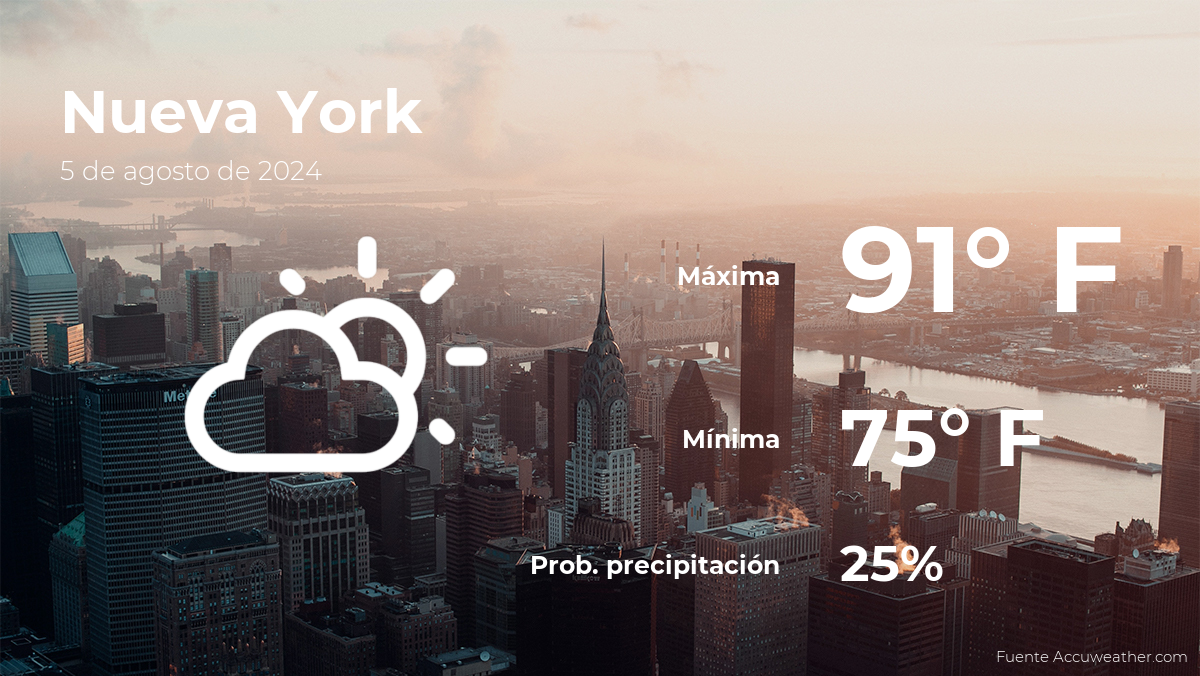
By The newspaper
05 Aug 2024, 06:00 AM EDT
What should you wear when you go out in New York this Monday? The weather forecast for New Yorkers in the next few hours predicts temperatures ranging from a high of 91 degrees Fahrenheit (33ºC) to a low of 75 degrees Fahrenheit (24ºC). On the other hand, the wind chill or “real temperature” forecast for today will be a high of 100ºF (38ºC) and a low of 100ºF (38ºC).
Is it going to rain? This is certainly your next question and we have the answer for you. According to the forecasts, the chance of precipitation is 25% during the day and 21% at night. Cloudiness, on the other hand, will be 12% during the day and 13% at night.
Wind gusts will reach a maximum of 4.35 mph during the day and 4.35 mph at night, so it is recommended to wear appropriate clothing. During this time of year, the first rays of the Sun reach us at sunrise at 05:57 a.m., while it sets on the horizon at 8:06 p.m. In total, we will have 14 hours of sunshine during the day.
As for the weather in New York tomorrow, the sky will be overcast with thunderstorms and rain. Temperatures will range between 66 and 84 degrees Fahrenheit (19 and 29ºC). The chance of rain will be 90% in the morning, 98% in the afternoon and 90% at night.
Don’t forget to check out the latest weather news at www.eldiariony.com/clima
The weather in New York
New York has a mostly humid climate, characterized by cold winters and warm summers. Precipitation is frequent throughout the year, with thunderstorms during the summer and snowfall in the winter. The proximity of the Atlantic coast helps to soften the extreme temperature swings. The coldest months are between December and March, while the hottest are between July and August.
What is the climate like in the United States?
A country as large as the United States has very contrasting climates depending on the area and time of year. For example, on the East Coast, the predominant climates are the humid subtropical climate in the southeastern part of the country and the humid continental climate further north, specifically at latitudes between 40° N and 70° N.
While the humid subtropical climate is characterized by very hot and humid summers and cool winters with abundant rainfall in coastal areas, the continental climate presents rainfall throughout the year that changes to winter and strong storms in the central summer months.
There are at least three major climates that predominate in the western United States: semiarid, arid, and Mediterranean. The cold semiarid climate covers the central part of the West and from north to south of the United States, with little rainfall and low temperatures.
The Southwest has a cold to hot arid climate with freezing winters and mild summers and very mild summers and warm winters. Both have little chance of precipitation throughout the year. The Mediterranean climate occurs in the coastal area of the American West and has rainy, mild winters and hot, dry summers.
